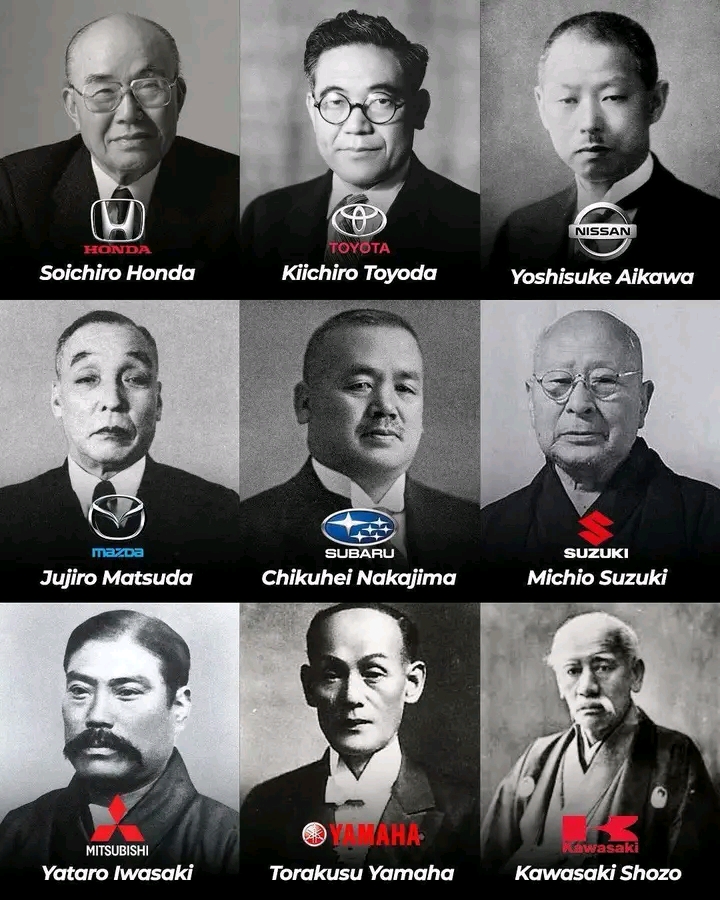Japan’s rise as a global powerhouse in the automotive industry is rooted in the ingenuity and determination of pioneering individuals whose innovations reshaped transportation. From motorcycles to cutting-edge cars, these nine visionaries laid the foundation for Japan’s industrial dominance, blending engineering excellence with bold business strategies.
Soichiro Honda, founder of Honda Motor Company in 1948, began his journey with motorcycles, driven by a passion for mechanical innovation. His company quickly gained recognition through motorsport achievements in F1 and MotoGP, proving Japanese engineering could compete globally.
Honda’s shift to automobile production in the 1960s emphasized fuel efficiency and reliability, setting new standards in an era of environmental consciousness. His philosophy of “racing to improve everyday cars” remains central to Honda’s identity.
Honda’s rival in mass production emerged through Kiichiro Toyoda: Architect of Toyota’s Legacy. Son of automatic loom inventor Sakichi Toyoda, Kiichiro transformed his family’s textile machinery business into Toyota Motor Corporation in 1937. Inspired by Ford’s assembly lines, Toyoda pioneered Japan’s version of mass production, integrating meticulous quality control. His “Just-in-Time” manufacturing system revolutionized efficiency, propelling Toyota into a global leader renowned for durability and innovation. Today, Toyota symbolizes Japan’s automotive excellence.
While Toyota focused on perfection through process, another industrial giant took shape under Yoshisuke Aikawa: The Zaibatsu Pioneer of Nissan. Aikawa merged industrial ambition with strategic vision to establish Nissan in 1933 under the umbrella of his conglomerate, Nihon Sangyo (Ni-San).
His zaibatsu model allowed Nissan to thrive by combining automotive engineering with diversified investments. Post-World War II, Nissan became synonymous with affordable, technologically advanced vehicles, cementing Aikawa’s legacy as a titan of Japanese industrialization.
Parallel to Nissan’s rise, a smaller but equally innovative brand emerged under Jujiro Matsuda: Mazda’s Rotary Engine Revolution. Matsuda took over Toyo Cork Kogyo in 1920, later renamed Mazda, steering it from machinery to vehicles. Postwar, he bet on Felix Wankel’s rotary engine, defying skeptics to produce the iconic Mazda Cosmo Sport in 1967.
This innovation distinguished Mazda as a brand willing to take risks, blending performance with unconventional engineering. His leadership ensured Mazda’s survival and relevance in a competitive market.
As Mazda carved its niche, another company shifted from the skies to the roads under Chikuhei Nakajima: From Aircraft to Subaru. Nakajima, founder of Nakajima Aircraft in 1917, pivoted his aerospace expertise into automobiles after WWII. His company evolved into Fuji Heavy Industries, launching Subaru in 1954.
Subaru’s signature boxer engines and all-wheel-drive systems drew from Nakajima’s aviation legacy, prioritizing safety and durability. The brand’s rugged yet innovative vehicles became a staple for drivers worldwide.
Meanwhile, in the realm of compact practicality, Michio Suzuki: Loom Weaver to Compact Car King forged a different path. Suzuki founded Suzuki Loom Works in 1909, specializing in textile machinery. Postwar demand for affordable transport led the company to pivot to motorcycles and, later, compact cars.
The Suzulight (1955), Japan’s first mass-produced lightweight car, showcased Suzuki’s knack for practicality. Today, Suzuki’s compact vehicles and motorcycles dominate global markets, reflecting Michio’s adaptive vision.
Beyond standalone automakers, the Iwasaki Family: Mitsubishi’s Industrial Empire shaped Japan’s broader industrial landscape. The Iwasaki family’s Mitsubishi conglomerate, founded as a shipping firm in 1870 by Yataro Iwasaki, expanded into banking, mining, and machinery. Mitsubishi Motors emerged in 1917, leveraging the group’s engineering prowess to produce Japan’s first series-production car.
Though automotive became a smaller division, Mitsubishi’s technological contributions, like the Pajero SUV, underscore its role in Japan’s automotive evolution.
Diversification also defined the legacy of Torakusu Yamaha: Harmony of Music and Motors. A watchmaker and reed organ builder, Yamaha founded Nippon Gakki (Yamaha Corporation) in 1887. Decades later, his company diversified into motorcycles in 1955, applying precision craftsmanship to engines.
Yamaha’s motorcycles and high-performance vehicle components became celebrated for their balance of power and refinement, bridging musical artistry with mechanical innovation.
Finally, anchoring Japan’s heavy industry was Kawasaki Shozo: Building Japan’s Industrial Backbone. Shozo established Kawasaki Heavy Industries in 1878, initially focusing on shipbuilding. His company expanded into railways, aerospace, and motorcycles, becoming synonymous with rugged, reliable machines.
Kawasaki’s motorcycles, first produced in the 1960s, embodied Shozo’s ethos of industrial versatility, contributing to Japan’s reputation for durable, high-performance vehicles.
These nine pioneers transformed Japan from an agrarian society into an automotive titan. Their willingness to innovate, adapt, and compete globally laid the groundwork for brands like Toyota, Nissan, Honda, and Subaru to become household names.
By blending traditional craftsmanship with bold technological leaps, they revolutionized not only Japan’s economy but also the way the world moves.

